April 1, 2006 - No foolin'
The first step is to cut up the Big Bang Timeline and affix it to a board, in reverse chronology. The second step will be to cut up all discussions/interviews, research materials, original texts etc. and group the topics discussed as they fit into this structure.
It is interesting to note that, as these clumps of text fall into their respective categoreies that everyone involved has so much more to say about the initiation of the Bang itself and topics that get closer to our present time (i.e. Planck Time/The Inflationary Period and then a leap to the relatively near present and beyond). The middle parts have some gaps, so far.
Everything in the Timeline does gets covered but there are, it seems, higher points of interest to the astronomers/physicists and laypersons, when combined. It's just an observation based upon the present data (April 1 and there's still much to add).
Meaning, the results are not fully in yet and after after all, this is only based upon the density of clumps, not upon the depth of data of which they may contain.
Leptons and hadrons, anybody?
(OR is that hadrons then leptons? Jeez, CUNY better give me an honarary degree after all this..whew! [a Masters is preferred]. I'll get it all right come graduation time, promise...hint hint ;)
Until then, nonetheless, and far beyond my/our Earthly concerns, the Universe does continues to expand...
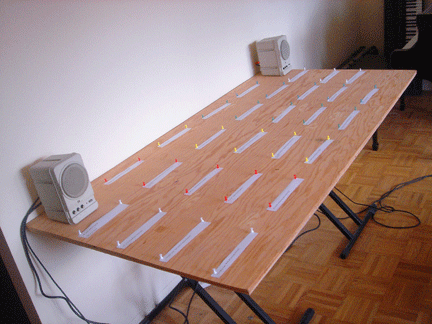
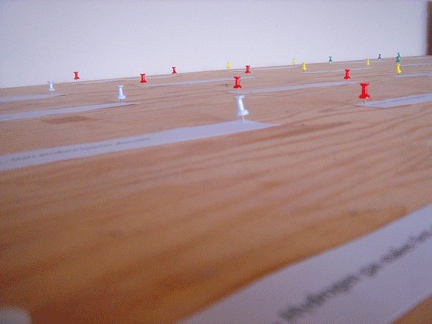
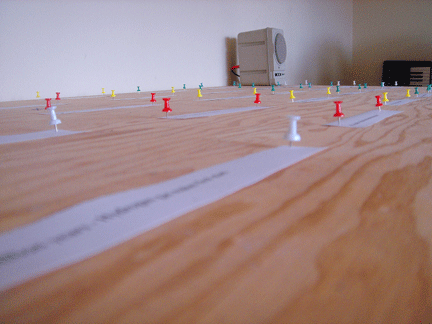
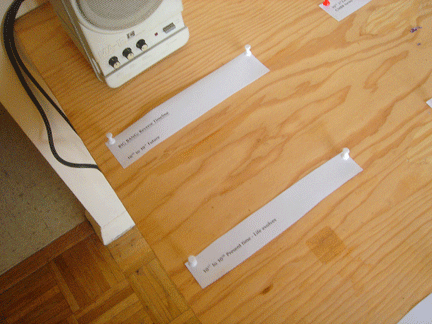
===============================================================
April
3, 2006 - Matter Pulls Together
The
text is now in order, all sections from various sources are grouped together and
printed out into a single document.
The basic sections are:
Prologue
Present
Day
Discovery of the Big Bang
Running the Film in Reverse
==============
Quantum
Gravity Era
The Big Bang and Expansion
Radiation
Atoms and Matter
Light
Breaks Free / Stars are Formed
The History of Our Solar System
Life Evolves
======
Present
Day
The Future (Running the Film Forward)
The End of the Universe?
Epilogue
All
pages are now pasted to the wall for major editing. It will be read aloud
in real time and timed with a watch to get an idea of how much needs to be cut,
condensed, reordered etc.
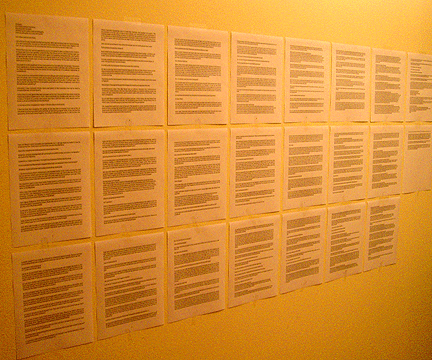
P.S.
at 22.5 pages it read in at a whopping 50 minutes in a normal delivery of speech,
around 2'30" a page! I've got to edit this down to 13 pages so the duration
will be more around 30 minutes or less because this is yet without the music added.
Back to the drawing (or editing) board.
===============================================================
April
11, 2006 - Super Strings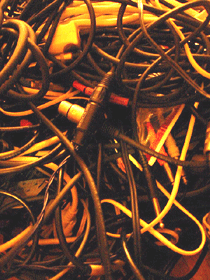

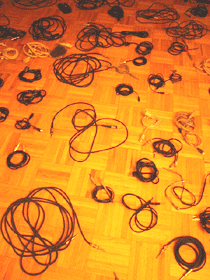
Setting
up the Equipment
===============================================================
May
01 , 2006 - Building the Grid
Diagram of the Structure
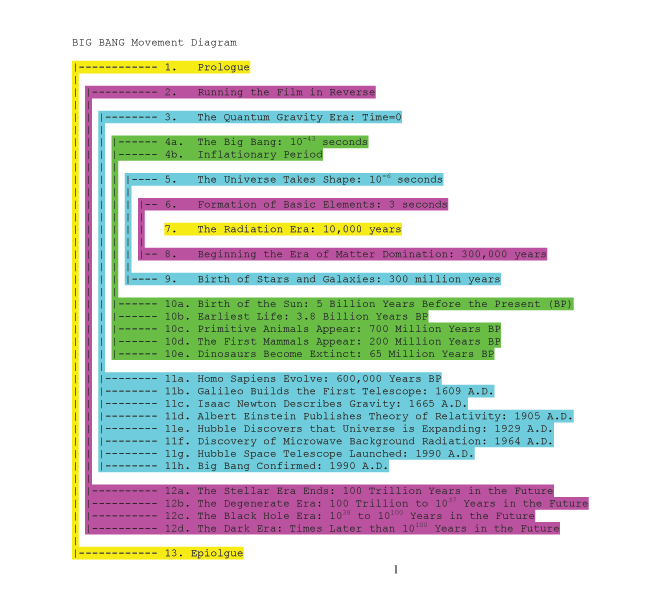
===============================================================
May 14, 2006 - Final Draft
BIG BANG
by Patrick Grant & Charles Liu with input
from Brian Schwartz
1. Prologue
It is Today and we are Here.
Albert Einstein once said, “The most incomprehensible
thing about the world is that it is at all comprehensible.”
This, the Universe and our consciousness of
it, isn't impossible. It's just so incredibly improbable that this
thing came together and that we can experience it.
It's amazing that we are even talking about
it right now.
We don’t know what
is happening at this moment far away in the universe. The light that we see from distant galaxies
left them millions of years ago, and in the case of the most distant objects that
we’ve seen, the light left more than 12 billion years ago.
So when we look
at the universe, we are seeing it as it was in the past.
What makes things hard to understand is not
how big they are but how complicated.
Inside a star, for example, everything is
broken down to its simplest constituents.
It's the same for the Big Bang.
If you know that the Universe is expanding
it means that it wasn't this big yesterday and it will be bigger tomorrow. That's where you really get the idea of running
back in time.
That's why we say, "Yes, the Universe
was probably small."
If you think of the Universe as something
like a gas, thinking of the stars and galaxies as gas particles, then when you
push them together they'll get hotter and hotter.
When we’re contemplating our place in the
Universe, a metaphor is always useful. Here’s
one:
Ever see a film of somebody playing on a pool
table and how all the balls go apart? Well, if you run the film backwards all
the balls would come together.
As it turns out, just like that film, we can
conceive of the universe going both forward and backward in time. So we can get back to where we were by reversing
the film.
That's how we can conceive of the Big Bang.
=====================================
2. Running
the Film in Reverse
We’re living now in an era where stars and
galaxies are important.
The biggest structures in the Universe are
superclusters of galaxies.
Matter is spread out in a huge web, and at
the nodes of the web are collections of thousands and thousands of galaxies.
It's Gravity playing itself out through Time.
It’s been more than 13 billion years since
the Big bang and things have grown bigger and bigger into larger structure.
But going backward in time, we see everything shrinking.
I'm going to take you back to where there
is no Space, there is no Time, and then I'm going to take you forward much more
slowly, through all the evolutions of the past until I get you back to where we are.
As you move further and further back in time
those clusters of galaxies are more and more separated and unstructured, more
and more uniform as you move back in the time that Gravity has been able to affect
them.
As you go further back, you see that
the clusters aren’t quite so big; and further back still, you see that the clusters
aren't really there at all.
Even further back, some 13 billion years ago,
there are no galaxies as we know them today.
There are clumps of matter, containing maybe
millions of stars, but nothing like the hundreds of billions in our Milky Way
galaxy now.
Go back even further and you wind up with
a Universe of individual stars that were huge, much, much bigger than our current
Sun, but they're still just stars. They’re the biggest structures in the cosmos.
Before that there aren't even stars. There's
just swirling gas that seems to be making snake-like patterns throughout the Universe.
Then you go back in time some more, and now
the gas is locked in tight with the photons – a blinding, glaring fog that light
cannot shine through.
Then from there we go through a period before
separation where all this matter and energy are tied together.
Before that you lose all distinction.
You can't even tell the difference between
matter and energy they're so interchangeable, they become one another so readily.
The Universe has shrunk and is so hot and
so dense that particles and anti-particles are annihilated in creating energy
and the timing of that is so rapid that the distinction between the particles
is lost.
Eventually
matter cannot exist because it's so hot and dense that you just have a tight bundle
of pure energy, infinitely dense and infinitely small.
This is the Planck Time, where the density
of the Universe was 1097 times greater than that of water.
Before that Time and Space don't exist
at all and the Laws of Physics as we know them totally break down.
=====================================
3. The
Quantum Gravity Era: Time=0
If someone asks, "What happened before
that?," then it becomes a question which has no meaning.
Time was created then. Space was created then. So we can’t answer that question, even though
it’s perfectly logical to ask it.
We have duck the question by saying, "It
didn't exist."
This is the Quantum Gravity Era, modeled by the idea Zero Point Energy
- a uniform quantum sea, in which bits of matter come together and fall apart
on a multitude of tiny, tiny scales.
Some of those quantum events could cause flashes of light, but most
are much, much smaller.
We can't go back to Time=0 but we can go back to Time=10 to the minus-43
second. That's the movie running backwards, and we can do that.
All the Laws of Physics, all that we know,
do not break down until that point.
At some moment, something goes out of whack – and that’s why the
Universe begins to exist - the equilibrium has somehow been broken.
Could it have been the result of parallel Universes bumping into
one another?
Could it have been Chaos? Like
where a water drop bounces off the surface of water in a pail, instead of just
falling in?
It’s something so unlikely that it’s a total surprise. It doesn't
make sense in the ordinary scheme of things.
Was this whole thing, our Universe, even meant to happen?
Or is it a part of a much greater cycle?
Who knows?
But amongst all the possible things that could have happened, this did.
=====================================
4a. The Big Bang:
10-43 seconds
[sound effect: Boom!]
At the Planck time, the smallest observable unit in we which we can
describe the Universe, the cataclysm we call the Big Bang generates space and
time, matter and energy
At this moment Gravity separates as the first of the Four Forces
that define our Laws of Physics. It’s a puny force compared to its future compatriots,
but the reach of its power is infinite.
For an incomprehensibly small fraction of a second, the universe
is a nearly infinitely dense, nearly infinitely hot fireball.
Then the Strong Force breaks off to become the second of the Four
Forces. Its power is tremendous – but its reach is incredibly small, only as far
as the sizes of the sub-nuclear particles it binds. We learned of its strength
when we first split the atom.
The remaining two forces have still not yet come into their own.
4b. The Inflationary
Period: 10-32 seconds
Then, all of a sudden, the Universe increases in size by a factor
of at least ten trillion trillion. It inflates!
Things that were once close together are now spread so far apart
that it might not even be possible that they could ever communicate again before
the end of the Universe. Even light traveling at its maximum speed may never get
from one end to the other in that time.
It’s now that big.
And, it all happened within one millionth
of one billionth of one trillionth of a second.
How do we know inflation happened?
The Universe has a flat geometry today – and a super-fast expansion like
this is one of the few ways that could have made it so. But nobody really knows why that is yet. It's
still a model in search of a theory.
Imagine an explosion and think of the light from that explosion as
the inflation of our Universe. Now think of the sound from that explosion as light
in the Universe. Even after the inflation
stops, the light may never catch up.
So Space itself expanded everywhere, and in every single spot, there
was that same infusion of energy.
Now, you might think that the Big Bang occurred and that for 13 billion
years things have been expanding out, and that these 13 billion years are all
that is.
It’s as if I turn on a light, and let that
light travel for 13 billion years in all directions, and that marks the whole
size of the Universe. Well, that's actually
only a very, very small part of the Universe.
No, the cosmos is way bigger than that; it's
much richer than that.
Let's
put it this way: if you and I were right next to one another and then inflation
occurred, we might be carried so far apart that, 13 billion years later, I would
have a big bubble of space around me that I’d
be aware of, and you would have a big bubble of space around you that you’d be aware of, but we'd still be so far apart that Time would
have to go on for a long, long, long while before it would even be possible that
we could communicate.
It’s as if this room were the size of the
Universe, and we could only see this much of it (makes a circle with fingers),
a small bubble of space 13 billion light-years in radius – that's tiny
compared to this room.
That’s it!
That’s the smallness of this tiny piece of the Universe that we can see.
What’s out there, beyond our reach, is so big that it’s almost indescribable,
almost incomprehensible. Almost…
…Wow, 10 trillion trillion. That’s a big number!
=====================================
5. The Universe Takes
Shape: Up to 10-6 seconds
The inflationary expansion fades away almost as quickly as it began.
After inflation ends, less than millionth of one billionth of one
trillionth of a second after the Big Bang, the universe continues to expand –
but not nearly so fast.
At this time, the temperature is still so high that everything is
still pretty uniform. Everything behaves basically the same.
All this energy is just slamming into itself. Nothing can take hold.
As the cosmos expands and cools, it also becomes less dense – more
spacious.
It becomes a thick soup of quarks and gluons and other sub-atomic
particles, but it’s still too hot for them to form anything yet.
There is just about as much matter as there is anti-matter.
Nothing can form.
The Universe keeps expanding and cooling down.
Then, the Weak Force and the Electromagnetic Force break apart.
They’re the third and fourth forces which govern our Universe today.
The Weak Force’s range of power is also very small. It governs some
nuclear processes, such as beta decay.
The Electromagnetic Force has, like Gravity, a range that is infinite.
We know it in many manifestations: it holds together atoms and molecules.
It is heat. It is light – visible and invisible.
The Universe comes closer and closer to the way that it works today.
Things have cooled down enough now that the
Four Forces begin to show their individual powers and begin to create the stuff
of which our Universe is made.
One second after the Big Bang the universe
is made up of fundamental particles and energy: quarks, electrons, photons, neutrinos
and less familiar types.
These particles smash together to form protons
and neutrons.
Particles and anti-particles form and begin
to annihilate each other.
For some reason, though, for every billion
and one particles of matter there were just a billion particles of antimatter.
And when the mutual annihilation was complete,
that billionth bit of matter was left – that's the stuff of our universe.
=====================================
6. Formation of Basic
Elements: 3 seconds
Things
have cooled down now to the point where protons and neutrons can come together,
and start to form the nuclei of simple elements: hydrogen, helium and lithium.
It
will take another third of a million years for electrons to be captured into orbits
around these nuclei to form stable atoms.
Now, I bet you learned in elementary school
that like-electric-charges dislike each other, they hate each other. They repel.
North repels North, and South repels South.
Now, helium has two protons. Of course there are neutrons involved too, but
for the moment, let’s consider the two protons.
The protons are positively charged.
How can two protons which want to repel each
other, be fit into one nucleus and be so
close together?
How could I get them together? To stay together
as Helium?
This is where the Strong Force comes in –
and a very strange force it is.
Only when I get the protons really close together
– to within a trillionth of an inch of one another – then !snap! They suddenly come together.
The Strong Force overcomes the repulsion even
though the protons are still trying to push themselves apart.
So without the separation of the Four Forces,
the quarks would not have pulled together to form protons, atomic nuclei, protons,
and all that.
Now, photons – particles of light – are the things that squirt out
when the electromagnetic force acts. Photons
carry the electromagnetic force, and they’re everywhere. But there is still no visible light yet.
Nothing shines. Nothing shines.
The fog of matter is still too thick for it to push through.
But at least, the basic building blocks of matter as we know it now
exist.
=====================================
7. The Radiation Era:
10,000 years
The Radiation Era began just minutes after the Big Bang and lasted
for more than 300,000 years.
This is the true start of the atomic kingdom.
The ratios of the early elements that existed then, are almost exactly
the same as those that exist in our stars today.
This
major era in the history of the universe is one in which most of the energy is
in the form of electromagnetic radiation – gamma rays and X rays; ultraviolet,
visible, and infrared light; microwaves and radio waves.
This
energy is the remnant of the primordial fireball, and as the universe expands,
the waves of radiation are stretched and diluted.
For the rest of the Radiation Era the Universe remains fully ionized, and
continues to expand.
The entire universe
is plasma, the so-called “fourth state of matter” – freely moving electrons and
atomic nuclei, the same as in the stars today.
Photons scatter off
these electrons and ions, reionizing any atoms that might form.
There are no electrons
orbiting a nucleus, because the heat is still so great that any electrons are
automatically stripped away.
During the Radiation
Era, then, the entire universe was sort of like the heart of a single gigantic
star.
During this period
the universe was in thermal equilibrium, and opaque to radiation.
Any free radiation
was scattered away by all the free electrons whizzing around.
=====================================
8. Beginning the Era
of Matter Domination: 300,000 years
At this moment, the energy in matter and
the energy in radiation are still equal.
But as the relentless cosmic expansion
continues, the waves of radiation – that is, of light – are stretched to lower
and lower energies, while the matter spreads thinner and thinner throughout space.
Now, neutral atoms form as electrons link
up with hydrogen, helium, and other atomic nuclei.
The cosmic background radiation hails
from this moment, and thus gives us a direct picture of how matter was distributed
at this early time.
By the way, disturbance from the cosmic background
radiation is something we have all experienced.
Tune your television to any channel it doesn't
receive, and about 1 percent of the dancing static you see is accounted for by
this ancient remnant of the Big Bang.
So the next time you complain that there is
nothing on TV, remember that you can always watch the infant universe.
By now the Universe has created all the matter
it will create. But only a few percent
of it will ever be visible to us.
The rest is Dark Matter. What is Dark Matter?
Oh… let’s say that the headlights of an oncoming 18-wheeler
are visible; that’s the visible matter.
The rest of the semi-truck, the big rig, is
the Dark Matter.…and that can slam into you just as well, whether you see it or
not.
We astronomers have found gravitational irregularities
in galaxy motions that show us that there is a lot of stuff out there that we
cannot see.
That is, we either think that the Laws of
Physics are correct, and that dark matter is there, or we have to believe that
our understanding of those laws is seriously flawed.
Time should tell.
In any case, the fog of matter is too thick.
Photons can’t get through that fog. It’s all still dark.
Nothing shines.
Yet.
=====================================
9a. Birth of Stars
and Galaxies: 300 million years
Gravity amplifies slight irregularities in the density of the primordial
gas.
Even as the universe continues to expand rapidly, pockets of gas
become more and more dense.
Stars ignite within these pockets, and groups of stars become the
earliest galaxies.
Now it shines. Now it shines.
Brilliant visible light shoots out and fills the Universe.
Now with fusion in the stars all of the elements get created.
9b. Birth of the Sun:
5 Billion Years Before the Present (BP)
As the Universe expands, it becomes more complex, more interesting,
more varied.
The sun forms within a cloud of gas in a spiral arm of the Milky
Way Galaxy.
A vast disk of gas and debris that swirls around this new star gives
birth to planets, moons, and asteroids. Now,
if you’re worried about something, consider this:
"Every second in the Sun 600 million
tons of hydrogen are being converted to 596 million tons of helium, and 4 million
tons disappear – converted into energy according to the formula E=MC2.
This has been going on for nearly 5 billion
years and will go on for another 5 billion years.
This star is one of hundreds of billions in
our galaxy and there are tens of billions of galaxies - and you're worried about
something?" Think about it.
Earth is the third planet out in our Solar
System.
Beyond the other specialties like the stars
and planets, Earth brings with it the ultimate specialty: Life.
=====================================
10b. Earliest Life:
3.8 Billion Years BP
The most wonderful thing we know about in
the universe is life. It’s the most complicated
emergent phenomena we know of.
Sure,
the Big Bang is complex. But it’s much,
much more difficult to understand even the simplest living organism.
I’m
always amazed when we study the simple beginnings of life.
We need to understand, not just how the necessary chemical elements have
been made but how they’ve forged themselves into something complicated enough
to develop into life as we know it.
Why is there life here? There are lots of
fundamental factors that have to be just right for life to exist: how stars form,
how planets form, how close this planet is to this star, and so on and so on.
If the numbers that represent any of those
factors were "off" by even a little… then this whole world would be
very different.
We can keep working the formula, as best as
we know how, until we get a very small number representing the probability of
the occurrence of life.
But, this very small number, when multiplied
by the billions and trillions of stars in the universe, makes it almost certain
that there is life elsewhere.
On this planet, the very first life forms are microscopic
living cells which begin to evolve and flourish in the early Earth's watery, volcanic
environments.
10c. Primitive Animals
Appear: 700 Million Years BP
These
are mostly flatworms, jellyfish and algae. By half a billion years before the
present, large numbers of creatures with hard shells appear. Eventually evolution
leads to the era of the dinosaurs.
10d. The First Mammals
Appear: 200 Million Years BP
The very first mammals, our ancestors, evolved from a class of reptiles
that evolved mammalian traits often becoming nothing more than sustenance for
their evolutionary forebears.
10e. Dinosaurs Become
Extinct: 65 Million Years BP
An
asteroid – or it could have been a comet – slams into the northern part of the
Yucatan Peninsula in Mexico.
This world-wide cataclysm brings to an end the long age of the dinosaurs,
and allows mammals to diversify and expand their ranges. Otherwise, intelligent
life on our planet may have evolved from reptiles making it even less possible
that we’d be here right now.
=====================================
11a. Homo Sapiens
Evolve: 600,000 Years BP
Our earliest ancestors evolve in Africa from the primates and spread
out over the world.
According to the 2nd Law of Thermodynamics,
entropy is always increasing –everything is slowly losing its distinctiveness
and becoming more and more chaotic.
That's only true on the largest scale.
On the small scale, counter to the increase
of entropy, we evolve. Over the millennia,
we build societies. We invent language,
philosophy, art, and science.
11b. Galileo Builds
the First Telescope: 1609 A.D.
Galileo builds his first telescope. He sees mountains on the Moon,
the phases of Venus, the moons of Jupiter, and the stars in the Milky Way.
11c. Isaac Newton
Describes Gravity: 1665 A.D.
Isaac Newton realizes that gravitational force accounts for falling
bodies on Earth as well as the motion of the planets in orbit around the Sun.
This realization extends the principles of earthly behavior to the realm of the
heavens.
11d. Albert Einstein
Publishes Theory of Relativity: 1905 A.D.
Albert Einstein recognizes the speed of light as the absolute speed
limit within the universe and unites the previously separate concepts of space
and time into a unified spacetime.
General relativity replaces Newton's model of gravitational force.
Gravity is now understood as the response of bodies to distortions in
spacetime which matter itself creates.
11e. Edwin Hubble
Discovers that the Universe is Expanding: 1929 A.D.
Edwin Hubble discovers that the universe is expanding in all directions.
This shows that the universe is not static,
but dynamic – continually changing – continually evolving.
We now know that
our galaxy is only one of perhaps a hundred billion, with each galaxy itself containing
millions, billions, even trillions of stars.
11f. Discovery of
Microwave Background Radiation: 1964 A.D.
Scientists working in New Jersey discover the cosmic background radiation
that bathes the earth from all directions in space. (Imagine that: New Jersey!)
This radiation is the afterglow of the Big Bang.
11g. Hubble Space
Telescope Launched: 1990 A.D.
A twelve-ton telescope, equipped with a 94-inch mirror, is sent into
orbit by astronauts aboard the space shuttle Discovery.
Evidence gathered
with the Hubble Space Telescope suggests that the universe will probably expand
forever – or at least, anyway, that the universe won’t recollapse for at least
ten billion years.
By that time, assuming
that we haven’t evolved as a species and colonized well beyond our Solar System,
humanity will long since have died out, extinguished along with our Sun.
The words of Carl Sagan ring truer than ever: “Our planet is a lonely speck in the great
enveloping cosmic dark. In our obscurity, in all this vastness, there is no hint
that there is anyone who will come and save us from ourselves.”
11h. Big Bang Confirmed:
1990 A.D.
The new Cosmic Background Explorer satellite is used to measure in
detail the spectrum of the cosmic microwave background radiation.
The results show that the radiation is in nearly perfect agreement
with the Big Bang model of the birth of creation. At last, the Big Bang Theory is confirmed!
=====================================
12b. The Stellar Era
Ends: 100 Trillion Years in the Future
As long as it keeps on expanding and does not recollapse under the
pull of its own gravity, the universe will gradually fade away.
During this era, most of the energy generated by the universe is
in the form of stars burning hydrogen and other elements in their cores.
12c. The Degenerate
Era: 100 Trillion to 1037 Years in the Future
Most of the mass that we can currently see in the universe is locked
up in degenerate stars, those that have blown up and collapsed into black holes
and neutron stars, or have withered into white dwarfs.
Energy in this era is generated through proton decay and particle
annihilation.
12d. The Black Hole
Era: 1038 to 10100 Years in the Future
The only stellar-like objects remaining are black holes of widely
disparate masses, slowly – oh-so-slowly – evaporate away.
12e. The Dark Era:
Times Later than 10100 Years in the Future
At this late time, all protons have decayed and all black holes have
evaporated.
Only the waste products from these processes remain: mostly neutrinos,
electrons, positrons, and photons of colossal wavelength.
For all intents and purposes, the universe as we know it is gone.
A universe that came from nothing in the Big
Bang has disappeared into nothing.
Its glorious existence not even a memory.
=====================================
13. Epilogue
It is today, and we are here.
Our universe is very unlikely and unique, but we do have this Universe and if we're going
to have any universe at all, it's kind
of neat that we have this one.
The
Big Bang theory describes how the universe developed from an almost featureless
explosion to something that's been broken up into huge clusters of galaxies and
huge empty spaces.
The Big Bang
Was neither big Nor did it bang
Within or Without.
For outside,
There was no Time & Space
To
carry the sound -
And inside
There was never any silence
To know
there was sound.
“It is Today and we are Here.”
For most of us, this statement will hold true
for tomorrow.
But will it in a week? In a year? In a century?
All things are finite, it seems, even the
Universe in which we live, at least as far as we understand it. Today.
So what then? Will the Universe contract to begin the cycle again?
And again?
Who knows?
Here’s one thing we do know:
The questions we’ll
have to answer are the ones we have yet to ask.
[MUSIC STOP]
Any questions?
THE END
===============================================================
Found
Quotations to be Inserted (?)
There is a theory which states that if ever anybody discovers exactly what the Universe is for and why it is here, it will instantly disappear and be replaced by something even more bizarre and inexplicable. There is another theory which states that this has already happened.
Duct
tape is like the force. It has a light side, a dark side, and it holds the universe
together....
Only two things are infinite, the universe and human stupidity,
and I'm not sure about the former.
In answer to the question of why it happened, I offer the modest proposal that our Universe is simply one of those things which happen from time to time.
It is well to remember that the entire universe, with one trifling exception, is composed of others.
Technology is a way of organizing the universe so that man doesn't have to experience it.
The universe is a big place, perhaps the biggest.
I'm astounded by people who want to 'know' the universe when it's hard enough to find your way around Chinatown.
Reality is nothing but a collective hunch.
In the beginning the Universe was created. This has made a lot of people very angry and has been widely regarded as a bad move.
The crux... is that the vast majority of the mass of the universe seems to be missing.
Programming today is a race between software engineers striving to build bigger and better idiot-proof programs, and the Universe trying to produce bigger and better idiots. So far, the Universe is winning.
There is a coherent plan in the universe, though I don't know what it's a plan for.
Sometimes I think the surest sign that intelligent life exists elsewhere in the universe is that none of it has tried to contact us.
We are an impossibility in an impossible universe.
My theology, briefly, is that the universe was dictated but not signed.
I'm worried that the universe will soon need replacing. It's not holding a charge.
The creator of the universe works in mysterious ways. But he uses a base ten counting system and likes round numbers.
The two most common elements in the universe are Hydrogen and stupidity.
Everything you've learned in school as "obvious" becomes less and less obvious as you begin to study the universe. For example, there are no solids in the universe. There's not even a suggestion of a solid. There are no absolute continuums. There are no surfaces. There are no straight lines.
Works of art, in my opinion, are the only objects in the material universe to possess internal order, and that is why, though I don't believe that only art matters, I do believe in Art for Art's sake.
The effort to understand the universe is one of the very few things that lifts human life a little above the level of farce, and gives it some of the grace of tragedy.
When they discover the center of the universe, a lot of people will be disappointed to discover they are not it.
If you want to make an apple pie from scratch, you must first create the universe.
Humor
is just another defense against the universe.
Not only is the universe stranger
than we imagine, it is stranger than we can imagine.
In the part of this universe that we know there is great injustice, and often the good suffer, and often the wicked prosper, and one hardly knows which of those is the more annoying.
If it's true that our species is alone in the universe, then I'd have to say that the universe aimed rather low and settled for very little.
The universe may have a purpose, but nothing we know suggests that, if so, this purpose has any similarity to ours.
Wonder is what sets us apart from other life forms. No other species wonders about the meaning of existence or the complexity of the universe or themselves.
It's important that someone celebrate our existence... People are the only mirror we have to see ourselves in. The domain of all meaning. All virtue, all evil, are contained only in people. There is none in the universe at large. Solitary confinement is a punishment in every human culture.
At the height of laughter, the universe is flung into a kaleidoscope of new possibilities.
I cannot believe that the inscrutable universe turns on an axis of suffering; surely the strange beauty of the world must somewhere rest on pure joy!
Go confidently in the direction of your dreams! Live the life you've imagined. As you simplify your life, the laws of the universe will be simpler.
The universe will reward you for taking risks on its behalf.
There's only one corner of the universe you can be certain of improving, and that's your own self.
If I have lost confidence in myself, I have the universe against me.
There is but one temple in the universe and that is the body of man.
The universe seems wondrous to me, with or without God. It has powerful lines and uncompromising ways. Patience and time sit like sages on the planets, strong and impersonal. There is a stark beauty to all of this.
Einstein
said God doesn't play dice with the universe, but I don't know--maybe not as a
whole, but I think he gets a pretty big kick out of messing in peoples' back yards.
I've come to believe that each of us has a personal calling that's as
unique as a fingerprint - and that the best way to succeed is to discover what
you love and then find a way to offer it to others in the form of service, working
hard, and also allowing the energy of the universe to lead you.
Listen. Do not have an opinion while you listen because frankly, your opinion doesn't hold much water outside of Your Universe. Just listen. Listen until their brain has been twisted like a dripping towel and what they have to say is all over the floor.
The universe is not hostile, nor yet is it friendly. It is simply indifferent.
You can call it the 'Perfect Moment' when the universe aligns and the music in your head actually matches the music outside and all is well.
The universe is not required to be in perfect harmony with human ambition.
Who are we? We find that we live on an insignificant planet of a humdrum star lost in a galaxy tucked away in some forgotten corner of a universe in which there are far more galaxies than people.
My own suspicion is that the universe is not only queerer than we suppose, but queerer than we *can* suppose.
God does not play dice with the universe; He plays an ineffable game of his own devising, which might be compared, from the perspective of any of the other players, to being involved in an obscure and complex version of poker in a pitch dark room, with blank cards, for infinite stakes, with a dealer who won't tell you the rules, and who smiles all the time.
Nature is wont to hide herself.
Much learning does not teach understanding.
You could not step twice into the same river; for other waters are ever flowing on to you.
The road up and the road down is one and the same.
It is better to hide ignorance, but it is hard to do this when we relax over wine.
A man's character is his fate.
The universe is change; our life is what our thoughts make it.
Wisdom
and spirit of the Universe!
Thou soul is the eternity of thought!
That giv'st
to forms and images a breath
And everlasting motion! Not in vain
By day
or star-light thus from by first dawn
Of childhood didst thou intertwine for
me
The passions that build up our human soul,
Not with the mean and vulgar
works of man,
But with high objects, with enduring things,
With life and
nature, purifying thus
The elements of feeling and of thought,
And sanctifying,
by such discipline
Both pain and fear, until we recognize
A grandeur in
the beatings of the heart.
If we long to believe that the stars rise and set for us, that we are the reason there is a Universe, does science do us a disservice in deflating our conceits?
Man, unlike any other thing organic or inorganic in the universe, grows beyond his work, walks up the stairs of his concepts, emerges ahead of his accomplishments.
We are just an advanced breed of monkeys on a minor planet of a very average star. But we can understand the Universe. That makes us something very special.
Men are confused. They're conflicted. They want a woman who's their intellectual equal, but they're afraid of women like that. They want a woman they can dominate, but then they hate her for being weak. It's an ambivalence that goes back to a man's relationship with his mother. Source of his life, center of his universe, object of both his fear and his love.
For animals, the entire universe has been neatly divided into things to (a) mate with, (b) eat, (c) run away from, and (d) rocks.
The belief that there are other life forms in the universe is a matter of faith. There is not a single shred of evidence for any other life forms, and in forty years of searching, none has been discovered. There is absolutely no evidentiary reason to maintain this belief.
Old age, calm, expanded, broad with the haughty breadth of the universe, old age flowing free with the delicious near-by freedom of death.
The number of books will grow continually, and one can predict that a time will come when it will be almost as difficult to learn anything from books as from the direct study of the whole universe. It will be almost as convenient to search for some bit of truth concealed in nature as it will be to find it hidden away in an immense multitude of bound volumes.
Duct tape is like the force. It has a light side, and a dark side, and it holds the universe together.
The forces of good and evil are working within and around me, I must choose, and in a free will universe I do have a choice.
The universe is full of magical things, patiently waiting for our wits to grow sharper.
The grace of God means something like: Here is your life. You might never have been, but you are because the party wouldn't have been complete without you. Here is the world. Beautiful and terrible things will happen. Don't be afraid. I am with you. Nothing can ever separate us. It's for you I created the universe. I love you. There's only one catch. Like any other gift, the gift of grace can be yours only if you'll reach out and take it. Maybe being able to reach out and take it is a gift too.
A penny will hide the biggest star in the Universe if you hold it close enough to your eye.
Some scientists claim that hydrogen, because it is so plentiful, is the basic building block of the universe. I dispute that. I say that there is more stupidity than hydrogen, and that is the basic building block of the universe.
We know next to nothing about virtually everything. It is not necessary to know the origin of the universe; it is necessary to want to know. Civilization depends not on any particular knowledge, but on the disposition to crave knowledge.
Programming today is a race between software engineers stirring to build bigger and better idiot-proof programs, and the universe trying to produce bigger and better idiots. So far, the universe is winning.
I used to think it was awful that life was so unfair. Then I thought, wouldn't it be much worse if life were fair, and all the terrible things that happen to us come because we actually deserve them? So, now I take great comfort in the general hostility and unfairness of the universe.
A human being is part of a whole, called by us the Universe, a part limited in time and space. He experiences himself, his thoughts and feelings, as something separated from the rest--a kind of optical delusion of his consciousness. This delusion is a kind of prison for us, restricting us to our personal desires and to affection for a few persons nearest us. Our task must be to free ourselves from this prison by widening our circles of compassion to embrace all living creatures and the whole of nature in its beauty.
You must not for one instant give up the effort to build new lives for yourselves. Creativity means to push open the heavy, groaning doorway to life. This is not an easy struggle. Indeed, it may be the most difficult task in the world, for opening the door to your own life is, in the end, more difficult than opening the doors to the mysteries of the universe.
The Universe is full of magical things, patiently waiting for our wits to grow sharper.
We do not have to visit a madhouse to find disordered minds; our planet is the mental institution of the universe.
You have to believe that the universe will provide.
To endure oneself may be the hardest task in the universe. You cannot hire a wise man or any other intellect to solve it for you. There's no writ of inquest or calling of witness to provide answers. No servant or disciple can dress the wound. You dress it yourself or continue bleeding for all to see.
There is only one corner of the universe you can be certain of improving, and that's your own self.
Man is but a reed, the most feeble thing in nature, but he is a thinking reed. The entire universe need not arm itself to crush him. A vapour, a drop of water, suffices to kill him. But if the universe were to crush him, man would still be more noble than that which killed him, because he knows that he dies and the advantage which the universe has over him; the universe knows nothing of this.
The
effort to understand the universe is one of the very few things that lifts human
life a little above the level of farce and gives it some of the grace of tragedy.
That young girl is one of the least benightedly unintelligent organic
life forms it has been my profound lack of pleasure not to be able to avoid meeting.
The story so far: In the beginning the Universe was created. This has made a lot of people very angry and has been widely regarded as a bad move.
[F]or academic men to be happy, the universe would have to take shape. All of philosophy has no other goal: it is a matter of giving a frock coat to what is, a mathematical frock coat. On the other hand, affirming that the universe resembles nothing and is only formless amounts to saying that the universe is something like a spider or spit.
The effort to understand the universe is one of the very few things that lifts human life a little above the level of farce, and gives it some of the grace of tragedy.
The universe is made of stories, not atoms.
We
do not have to visit a madhouse to find disordered minds; our planet is the mental
institution of the universe.
===============================================================
